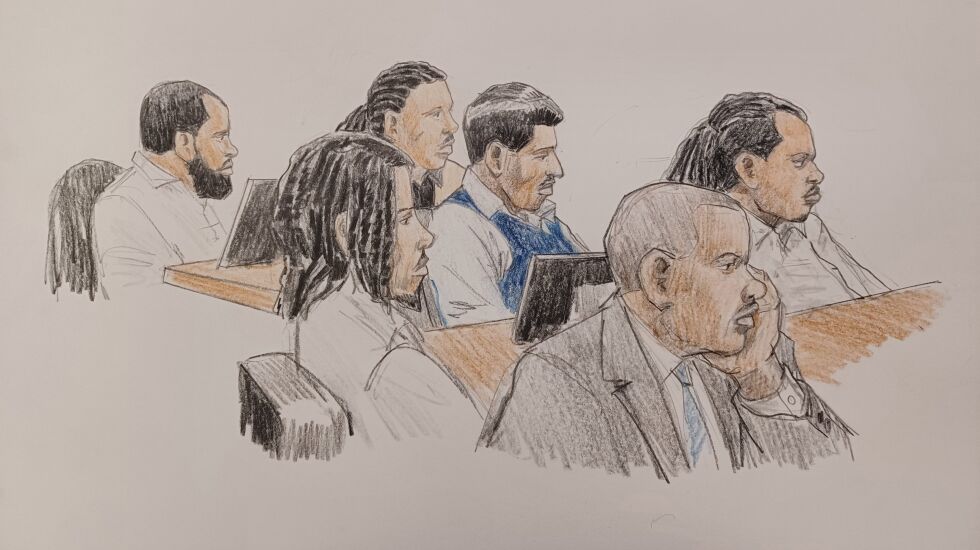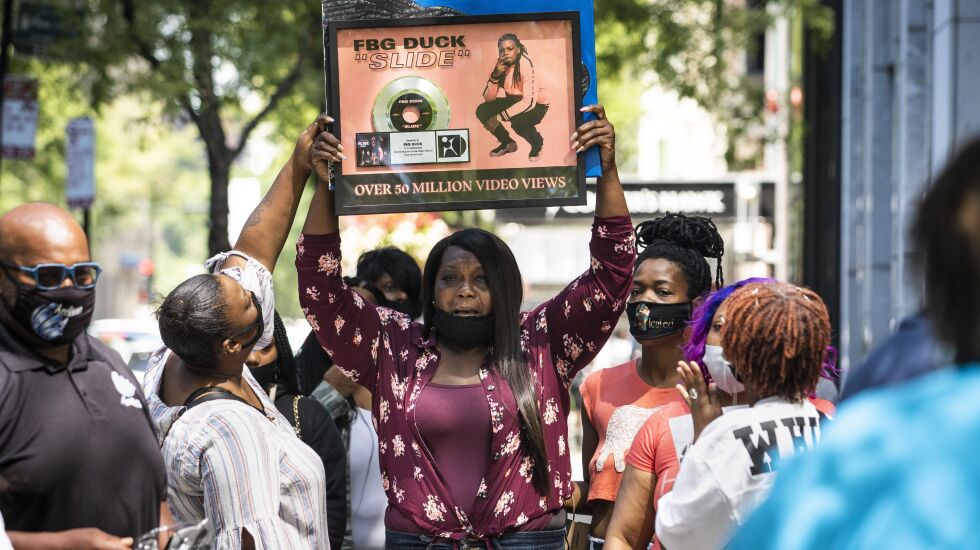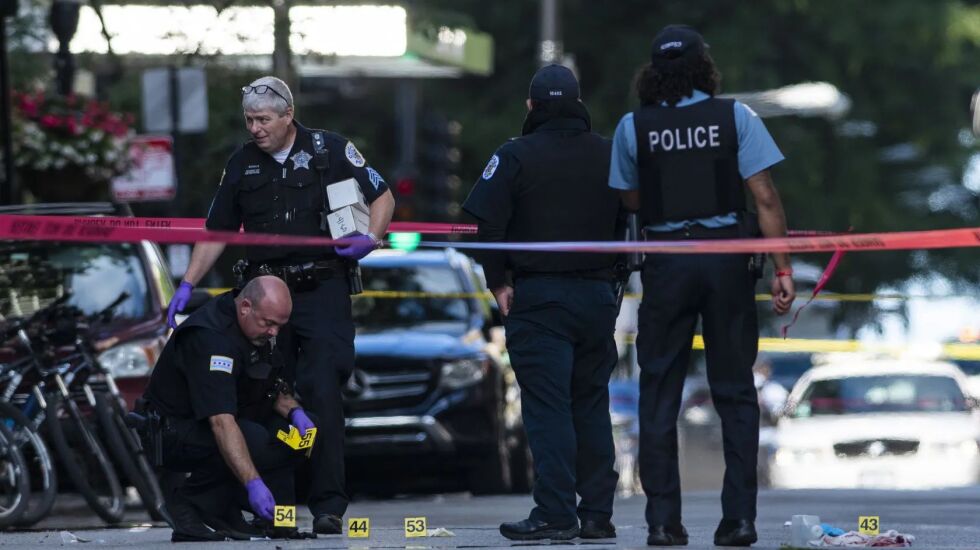
After final arguments slowly wound to a close, a federal jury on Wednesday began deciding the fate of six alleged gang members charged in the brazen killing of rapper FBG Duck on the Gold Coast.
The turbulent trial of the alleged members and associates of the Black Disciples’ O Block faction kicked off exactly three months ago, when the process of empaneling an anonymous jury began amid safety and security concerns surrounding the high-profile case.
The jury of five men and seven women were sent out to begin deliberations around 5:15 p.m. Wednesday. The jurors left by 6 p.m. and were set to resume Thursday morning.
Marred by delays, the proceedings before Judge Martha Pacold at the Dirksen Federal Courthouse have at times been painstakingly procedural and at others uproarious and outright bizarre.

Prosecutors allege that Duck, real name Carlton Weekly, was killed during a yearslong gang war between O Block and the Tookaville faction of the Gangster Disciples he claimed.
In closing out Wednesday, Assistant U.S. Attorney Jason Julien noted that testimony had shown O Block was an organized crew that held meetings, collected cash from its members and disciplined those who ran afoul of its rules.
Julien rattled off a list of people who had been killed during the gang conflict that he said culminated in Duck’s daytime slaying on Aug. 4, 2020.
“He was downtown, minding his business shopping and he was murdered — by those guys, by those six defendants,” Julien said. “He was murdered by O Block, a violent criminal enterprise. That’s what O Block is.”
The conflict was allegedly fueled by diss tracks between Duck and rapper King Von, an alleged O Block leader who has been accused of placing a bounty on Duck. King Von, real name Dayvon Bennett, was killed months after Duck in an apparently unrelated shooting in Atlanta.
On trial are Marcus “Muwop” Smart, 24; Christopher “C Thang” Thomas, 24; Kenneth “Kenny Mac” Roberson, 30; Charles “C Murda” Liggins, 32; Tacarlos “Los” Offerd, 32; and Ralph “Teezy” Turpin, 34.
All the defendants are charged with murder in aid of racketeering and conspiring to kill Duck. Except for Turpin, the defendants face five additional counts for using firearms to carry out the killing and wounding two others in the attack.

During closing arguments that stretched over four days, defense attorneys sought to poke holes in the evidence, dispel the government’s theory of the shooting and unravel the pivotal claim that defendants participated in the shooting based on their connection to O Block.
Prosecutors allege Turpin spotted Duck in a children’s clothing store on Oak Street and made a fateful call that ultimately summoned two cars to the swanky shopping district, where the other defendants allegedly gunned down Duck in front of the Dolce and Gabbana store.
But Turpin’s lawyer, Patrick Boyle, argued there’s no evidence that call happened, noting that authorities never got a search warrant for Turpin’s cellphone.
Turpin, however, was caught on video shortly before the shooting telling people on the phone that he saw Duck and had people “on their way.” After the shooting, he sent an alarming text message to his child’s mother, who had dated Duck, that contained only three laughing emojis.
With the government’s case hinging on proving that O Block is a criminal enterprise, Boyle said there’s no evidence to prove the claim that Turpin is a member of a gang faction that’s “cliqued up” with O Block. Boyle said Turpin had “moved on” and was no longer involved in the street life.
Roberson’s attorney, Cheryl Bormann, said the “most problematic” part of the government’s case against her client is that he was trying to maintain or increase his position in O Block by serving as a driver. Bormann noted he was a member of a different crew and insisted there’s nothing substantive to show his connection to O Block.
At the same time, she acknowledged that he and Liggins are friends and that his family members have lived at Parkway Gardens, the sprawling South Side housing complex that’s also known as O Block and allegedly serves as the faction’s power base.
“If he doesn’t have a position in O Block, he can neither increase or maintain it,” Bormann said of Roberson, who also has a pending murder case in Cook County court.
Roberson faces a mountain of evidence in Duck’s murder: His car’s path from Parkway Gardens to O Block was tracked by city cameras and license plate readers; he texted a witness that he was “on Duck” and later boasted about the killing; and a shell casing linked to the shooting was recovered from his car.

A lawyer for Offerd, the other alleged getaway driver, pointed to the video footage at Parkway Gardens that’s being used to identify many of the suspects. Attorney Richard Kling noted that the footage jumps for roughly four minutes as Offerd is getting into his car, arguing that there’s no indication Offerd actually drove away in it.
Kling suggested that Offerd’s cousin, Ezell Rawls, actually drove the car based on the light-colored sweatshirt he was seen wearing at the housing complex. Kling claimed that a city-owned camera showed the driver was wearing a similar-looking sweatshirt around the time of the shooting.
Witnesses testified that Offerd returned his Ford Fusion to a suburban car dealership shortly after the shooting. Offerd’s child’s mother testified that she picked him up from the dealership, along with Rawls and a person she said she assumed was Smart.
Rawls later took his own life, prosecutors have said.
Defense lawyers have insisted there’s no forensic evidence to prove the defendants were on Oak Street, and they’ve criticized the identifications made from surveillance footage at Parkway Gardens while seizing on the poor video quality and skips in the footage.
The lawyers have also slammed the troubled testimony of gang members who were used to identify the suspects and help prove O Block is an enterprise, noting that some were paid and offered leniency. That includes Martell “Trenches News” Wiley and Rakeem “FBG Butta” Wilton, YouTubers who turned the trial into an embarrassing spectacle.
“The proof doesn’t know what happened on that street,” Kling said. “The bottom line is, ladies and gentlemen of the jury, the evidence is not sufficient to convict beyond a reasonable doubt.”
After pushing back on the various defense arguments, Julien offered a different perspective: “The only verdict that’s consistent with the evidence is finding each one of those defendants over there guilty.
“Guilty, because that is what they are.”



!["[T]he First and Fifth Amendments Require ICE to Provide Information About the Whereabouts of a Detained Person"](https://images.inkl.com/s3/publisher/cover/212/reason-cover.png?w=600)



